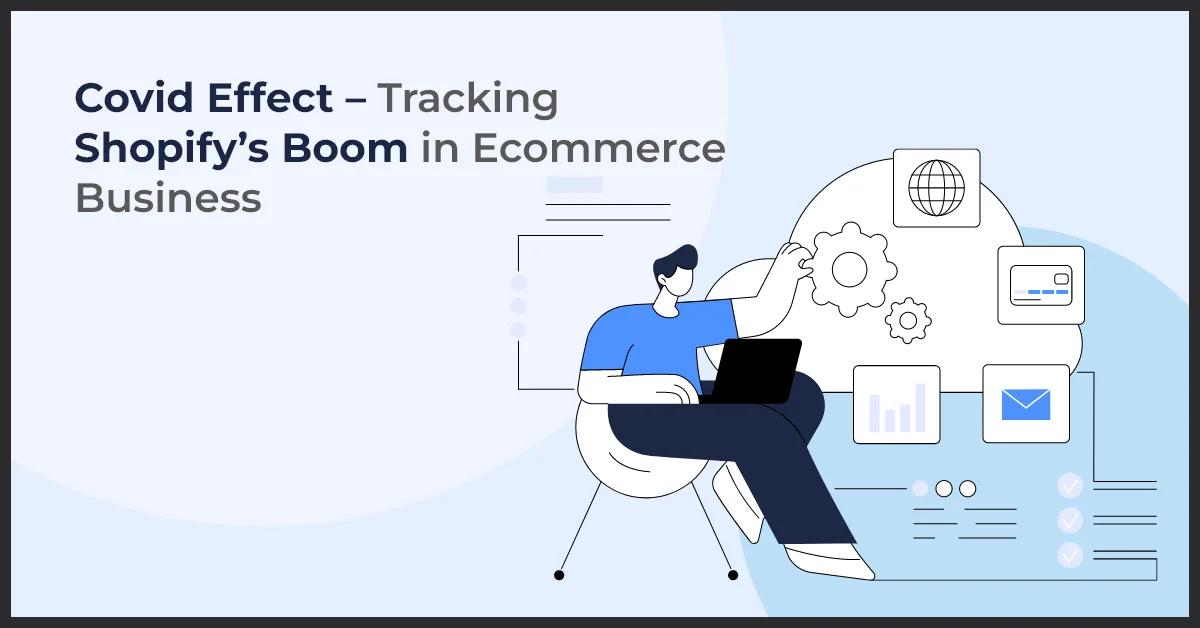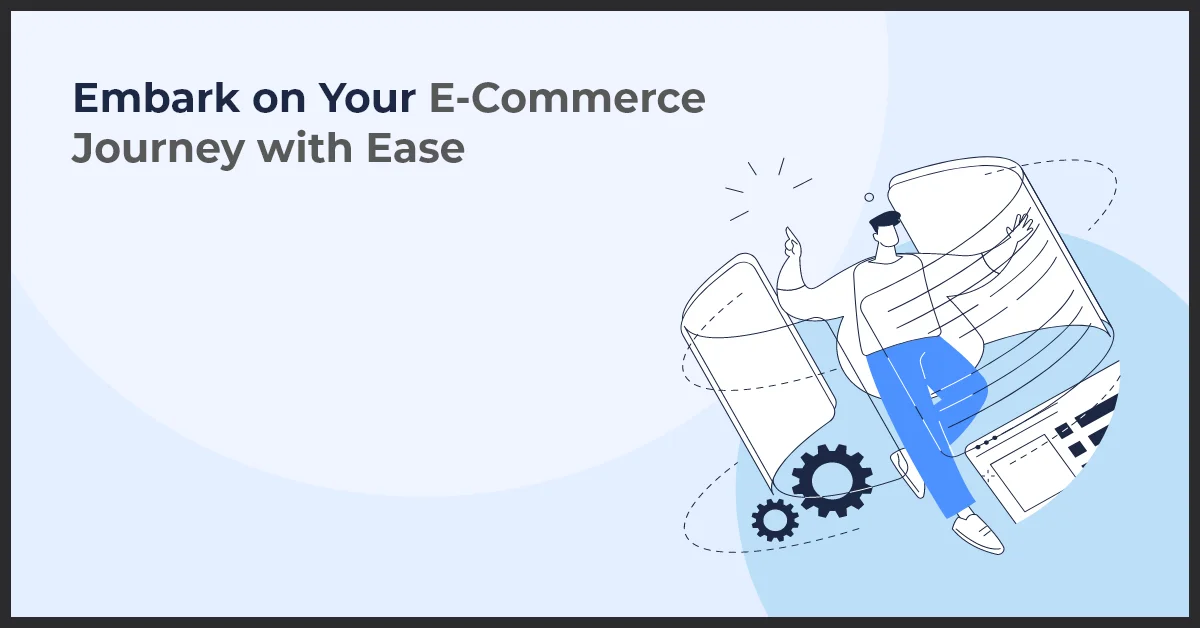Covid Effect – Tracking Shopify’s Boom in Ecommerce Business

Published on: February 24, 2022
Updated on: August 08, 2024
5917 Views
- Ecommerce
6 min read
The Covid-19 pandemic brought the world economy to a grinding halt. As governments around the world imposed strict lockdowns and other measures to save lives, it was the e-commerce industry that stepped up to ensure the supply of essential goods. 150 million people across the world online shopped for the first time since the pandemic according to a survey conducted by Shopify.
The growth in this business has been phenomenal and it was one of the rare sunshine sectors in the otherwise gloomy economic picture during the early waves of the pandemic. From a 13.6% share in retail sales in 2019, the e-commerce industry jumped to 19.5% by the end of 2021. Though the restrictions have eased since with vaccinations and more effective treatment protocols, this pandemic has been seen as a major inflection point for the eCommerce industry.
Ecommerce would continue to be the sweet spot in this decade. The global eCommerce industry is expected to surpass the $7 trillion mark by 2025 which would be more than double the $3.3 trillion back in 2019. This mega boom in eCommerce sales has coincided with Shopify’s boom in this area. It has been one of the biggest beneficiaries of the growth in the e-commerce business since the start of the pandemic. While the global eCommerce market saw a 19% increase in sales between 2019 and 2020, the corresponding growth for Shopify was more than 50%.
It is during this period that Shopify has onboarded hundreds of thousands of new stores. The number of new Shopify stores since the pandemic has grown by over 200%. Most of these have been small businesses that went online for the first time. Its ease of adoption and competitive pricing have been attributed as the key drivers for Shopify’s growth. Here we shall look at the growth of Shopify in this new world and how it continues to revolutionize the eCommerce industry.
Shopify’s Covid-19 Pandemic Boom
Shopify has positioned itself as the second most popular eCommerce platform behind WooCommerce. It has taken a big lead over competitors such as Squarespace, Magento, Weebly, Wix, and BigCommerce thanks to its ease of deployment and use. The eCommerce suite has been built with the idea of enabling small merchants without technical know-how to create and manage their stores efficiently. With tons of third-party apps to choose from, Shopify lets merchants build feature-rich online stores. All these have made it the go-to eCommerce platform for merchants who have gone online since the start of the pandemic.
As a leading provider of eCommerce infrastructure, Shopify has seen exponential growth in its revenue and user base since the start of the pandemic. It reported a 57% increase in revenue in 2021 compared to 2020. This is impressive as the eCommerce technology giant has reported almost 100% growth in revenue between 2019 and 2020. The eCommerce suite has been a trendsetter for the industry introducing new features and functionalities that improve user experience and drive more sales for the merchants. The focus has been to keep the users engaged throughout their buying journey and increase conversion rates.
Shopify’s Journey from Tool to Ecommerce Suite
Like most other unicorns, Shopify has had a thrilling journey from a mere online tool to a complete eCommerce ecosystem with all bells and whistles. Founders Tobias Lütke and Scott Lake built this tool in 2004 to power their online snowboard shop “Snowdevil” as there was no tool in the market that addressed their needs and the challenges. Back then there were no e-commerce tools for small online stores and the ones available were incredibly expensive.
They went about solving their problems in managing their snowboard shop. Having solved their problems, the duo launched Shopify as a set of eCommerce tools in 2006. It was primarily targeted at small online stores as there were limited options for this segment of the market. Shopify in its early avatar focused on key needs of online stores such as customizable store templates, inventory management features, payment gateway integration, etc. It was well-received by small eCommerce players and since then has added features and functionalities to become a comprehensive eCommerce suite.
The platform is highly secured with 256-bits SSL Certification and at the same time Level-1 PCI Compliant. It offers unlimited personalization options with hundreds of themes to choose from. These themes can be customized to meet the taste and needs of online store owners. It comes with out-of-box SEO tools that help in improving the store’s ranking on the search engines. Third-party apps can easily be integrated to further optimize stores.
In its current form, it is a complete ecommerce suite that lets merchants build, host, operate, and manage their online stores from a single dashboard. The suite brings in a host of tools and features that address different needs for online store owners such as marketing, customer engagement, sales, payment, and shipping.
Key Highlights of Shopify
We have already covered Shopify’s growth and its prospects in a post-Covid world and how it evolved from a mere ecommerce tool into an ecommerce ecosystem. Let us take you through 10 highlights of Shopify:
- Shopify is being used by more than 1.7 million merchants across 175 countries in the world and it is available in more than 20 languages
- Shopify contributed $319 billion in sales to the global ecommerce industry as it has democratized ecommerce
- There are more than 3000 apps on Shopify’s app store that address the varied needs of the users
- Shopify commands more than 18% share of the e-commerce tools and it sits just behind WordPress’ WooCommerce
- Shopify is expected to surpass $1 billion in revenue in 2022 and the company reported $988.6 million in 2021
- Shopify is a mobile-friendly platform with 79% of the traffic to its stores coming from mobile devices
- Shopify helps online stores earn customer loyalty with 50% of the sales coming from repeat customers
- The United States accounts for 62% of Shopify stores followed by the United Kingdom and Canada at 10% and 9% respectively
- Shopify’s 3D product images have increased sales for ecommerce merchants by as much as 250%
- Shopify pricing plans are competitive and highly affordable. Starting at just $29 mo the platform has left competitors behind
Final Thoughts
Despite easing of Covid restrictions across the world, Ecommerce is expected to grow exponentially. Millions of brick-and-mortar stores have gone online since the start of the pandemic and millions more would follow the suit in the coming years. Shopify is expected to be one of the major beneficiaries of the ecommerce revolution. Its ease of use, features, and flexibility would hold it in good stead in the coming years. As businesses fight it out in the competitive online market, Shopify would continue to power millions of stores across the world.
If you are looking for a team that can power your ecommerce dream and take your online store to greater heights, Growth Natives would be proud to partner with you. We have a young and energetic team that stays in sync with the latest developments in the ecommerce industry. To get started with your ecommerce journey, write to us at info@growthnatives.com or visit our website.



